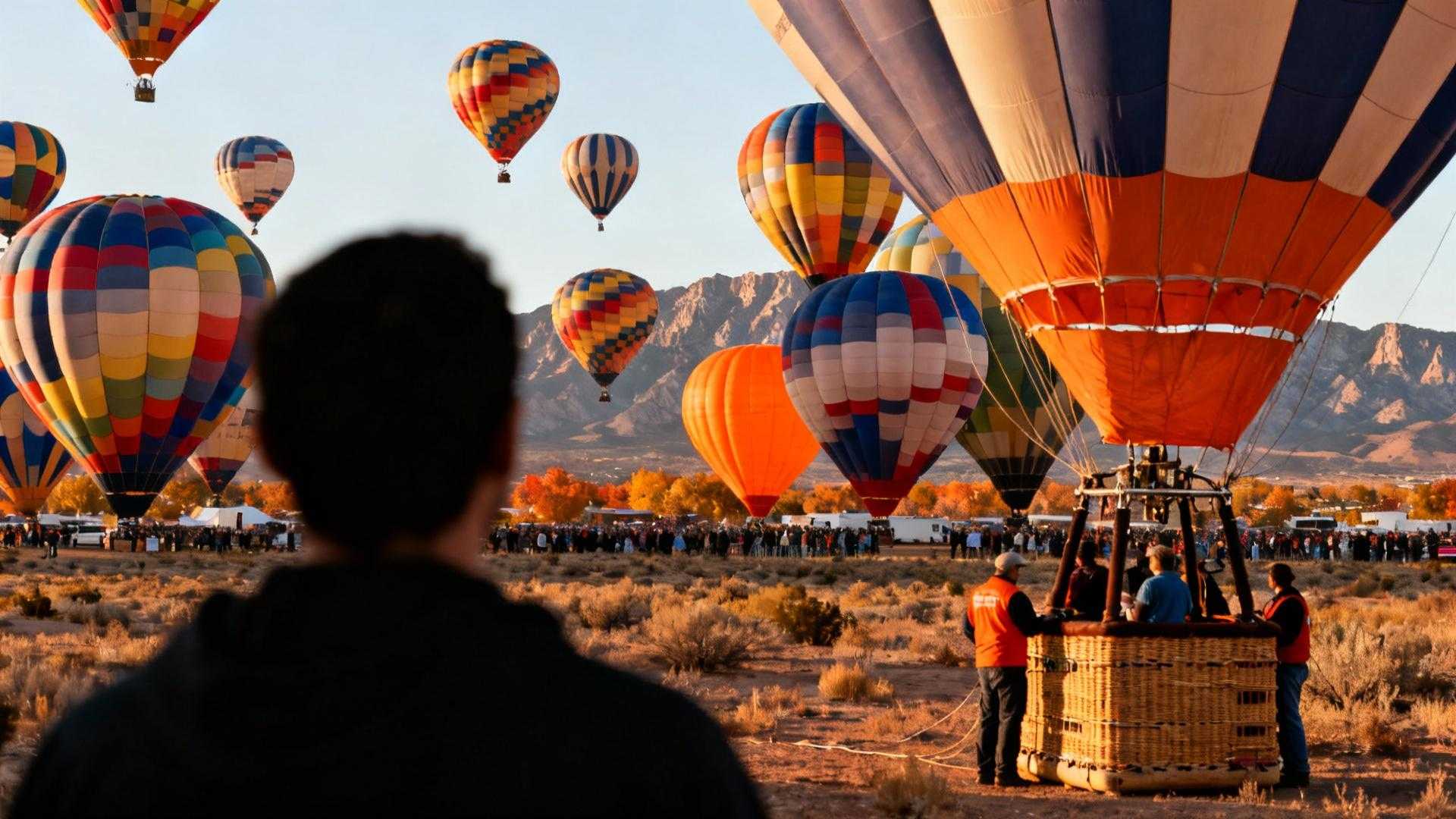I stand in pre-dawn darkness at Balloon Fiesta Park, watching 500 hot air balloons inflate across 78 acres of high desert terrain. The silence breaks at 5:47 AM when the first propane burners roar to life, and within 90 minutes, the entire New Mexico sky transforms into a floating canvas of color that exists nowhere else on Earth.
This isn’t just another balloon festival. Albuquerque hosts the world’s only mass ascension event where over 600 balloons launch in coordinated waves, creating a spectacle six times larger than any competing festival. And here’s what guidebooks rarely mention: volunteer crews who help launch these balloons often fly for free, turning $250 commercial rides into $0 opportunities for those willing to arrive at 4:30 AM.
The Thailand’s Yi Peng lantern festival creates similar sky-filling wonder, but New Mexico’s balloon fiesta operates on a scale that defies comparison—and costs just $10 for daily admission versus commercial aerial tours charging $200 elsewhere.
The atmospheric phenomenon that makes this possible
Why Albuquerque’s weather creates exclusive flying conditions
The “Albuquerque Box” is a meteorological rarity that occurs approximately three days during the festival’s first two weeks. Cool overnight air settles in the Rio Grande valley while warm air rises above, creating opposing wind directions at different altitudes. Pilots ascend into southbound currents, drift downriver, then descend into northbound surface winds that carry them back to launch sites—a circular flight path impossible at other balloon festivals.
The geography that protects this natural advantage
Sandwiched between the Sandia Mountains and West Mesa at 5,312 feet elevation, Albuquerque’s basin geography amplifies the Box effect. The city enjoys 270+ days of sunshine annually, providing consistent October mornings with 50°F temperatures and calm winds—conditions that let 600 balloons launch safely within two hours. Colorado’s mountain festivals face afternoon thermal turbulence that grounds balloons by 9 AM, but New Mexico’s high desert stability extends flying windows until noon.
The volunteer secret that transforms spectators into crew
How “zebras” earn free flights through dawn labor
Balloon pilots need 4-6 crew members for safe launches, and volunteers wearing black-and-white striped “zebra” shirts provide this essential support. Arrive at 4:30 AM, help unpack the envelope, hold guide ropes during inflation, and chase the landing site afterward—and pilots often reward dedicated crews with flight opportunities worth $250 commercially. Some crews return for decades, forming family-like bonds with pilot teams who protect this tradition fiercely.
The restricted pilot areas most visitors never see
Beyond public viewing zones, pilot briefing tents and launch field staging areas remain crew-only spaces where you’ll witness the real festival. Pilots discuss wind forecasts, share propane tank logistics, and coordinate mass ascension wave timing—insider knowledge that Kyoto’s protected bamboo forest guards with similar reverence. The silence before 500 burners ignite creates its own meditative cathedral, proving nature’s quiet amplifies spectacle’s impact.
The cultural heritage that grounds this aerial celebration
Why Native and Hispanic communities protect festival traditions
This high desert landscape spans 700 years of Pueblo and Hispanic heritage, and festival organizers integrate Native American artisan markets alongside balloon activities. Local communities view the event as collective cultural expression rather than tourist commodity—an attitude that keeps admission prices at $10 while maintaining environmental standards that limit propane emissions and mandate strict waste management protocols.
The economic impact that sustains regional identity
The festival contributes $186 million annually to Albuquerque’s economy, but locals balance tourism influx with quality-of-life protections. Launch field capacity remains capped, volunteer programs prioritize community participation, and smaller regional events in Taos, Gallup, and Elephant Butte offer intimate alternatives when crowds feel overwhelming—preservation strategies that Balinese farming communities employ to protect agricultural traditions.
The practical timing that rewards October planning
Why early October weather creates perfect conditions
The nine-day festival runs during early October’s optimal weather window when 70°F afternoon temperatures and 50°F mornings create stable atmospheric conditions. Fall foliage transforms the Sandia Mountains into golden backdrops, and autumn harvest traditions align with regional cultural celebrations—timing that offers 30% lower travel costs compared to summer peak seasons.
The 2026 preparation that starts now
Hotels within 15 miles of Balloon Fiesta Park book solid 11 months ahead, and volunteer zebra crew applications close by December for the following year’s festival. Mass ascension viewing requires arriving before 5 AM for optimal field positions, but the reward—watching 500 balloons paint the desert sky in coordinated waves—creates memories that justify every early alarm and every moment spent holding guide ropes in pre-dawn darkness.
Common questions about volunteering and visiting
Can anyone join zebra volunteer crews?
Yes, but physical stamina matters. Crews lift 40-pound propane tanks, hold guide ropes in wind gusts, and chase landing sites across open desert. Most pilots welcome enthusiastic first-timers willing to follow safety instructions precisely and commit to full dawn-to-landing schedules.
What distinguishes Albuquerque from smaller New Mexico balloon events?
Taos hosts 30 balloons with mountain backdrops and hands-on launch access for $35 admission. Gallup’s Red Rock Rally features 50 balloons over Navajo lands. Elephant Butte’s 20-balloon event offers lakeside launches. All provide more intimate pilot interactions, but none match Albuquerque’s mass ascension scale.
How does the festival protect environmental impact?
Propane emission policies, waste management mandates, and launch field capacity limits balance spectacle with high desert ecosystem protection. The festival demonstrates that massive cultural events can maintain environmental responsibility through community-driven sustainability standards.
